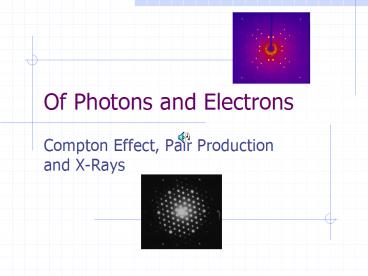Of Photons and Electrons - PowerPoint PPT Presentation
1 / 29
Title: Of Photons and Electrons
1
Of Photons and Electrons
- Compton Effect, Pair Production and X-Rays
2
What Is a Photon?
- Massless particle
- Travels with speed of light c 3.0x108 m/s
- Has momentum p E/c
- But E hf
- p E/c hf/c h/l l h/p
3
Photon Interactions With Matter
- Photoelectric Effect photon knocks electron out
of atom and disappears - Compton Effect photon scatters off electron and
loses energy (frequency) - Atomic excitation electron takes all of
photons energy and goes to higher energy state - Pair Production photon disappears, electron and
positron created
4
Compton Effect
- Used in astronomy to detect violent events in
distant galaxies - Used in nuclear medicine to treat cancer
5
Compton Effect is a Collision Between Photon and
Electron Resulting in a Lower Energy Photon
Courtesy OSHA http//www.osha-slc.gov/SLTC/radiof
requencyradiation/rfpresentation/ionizinglectur/sl
idepresentation/mainpage.html
6
Question
- What happens to the wavelength of a photon after
it Compton scatters? - (a) increases
- (b) decreases
- (c) remains the same
Dont forget Wavelength and frequency are
inversely related
7
Wavelength Increases
- l l (h/moc)(1 - cos f)
- f is angle of scattered photon with incident
e- after collision
Incident photon
f
Scattered photon
8
Compton Effect in Astronomy
The Imaging Compton Telescope (COMPTEL) utilizes
the Compton Effect and two layers of gamma-ray
detectors to reconstruct an image of a gamma-ray
source in the energy range 1 to 30 million
electron volts (MeV).
Graphics courtesy NASA Goddard Spaceflight Center
Lab for High Energy Astrophysics
9
What the Compton Telescope Sees the Gamma Ray
Universe
10
Cobalt 60 Gamma Ray Irradiation for Cancer
Treatment
Radiologists must understand how gamma rays
interact with tissues in the body.
11
Pair Production
- Involves creation of antimatter
- Minimum energy photon is 2mec2
e
photon
e-
2 x 9.11x 10-31 kg x(3.0x108 m/s)2 1.64x10-13 J
1.02 MeV
Rest Energy of one electron is 0.51 MeV
12
What Happens to the Positron?
- It annihilates electron at rest positron and
electron rest mass converts to photon energy - Produces two photons of energy 0.51 MeV each
- Photons must be emitted back to back to
conserve momentum
13
Find Wavelength of 1.02 Mev Photon
- l
h/p hc/E
(6.6 x 10-34 J-s)(3.0 x 108 m/s)/(1.64x10-13 J )
1.2 x 10-12 m
14
X -Ray Production
- When high speed electrons (30 150kV)slam into a
metal target (usually tungsten)x-rays are given
off - X-Rays are EM
- radiation with
- wavelength about
- 10-2 - 1 nm
15
Wavelength of an X-Ray
- Find the wavelength of the maximum energy x-ray
that can be produced by 100 kV electrons
h 6.63 x 10-34 J-s
l c/f hc/hf hc/E (6.63 x 10-34 J-s)(3x108
m/s)/(100 keV)x(1.6 x 10-16 J/keV) 0.012 nm
16
X-Ray Emission by Atoms
- Atoms become excited higher energy state
- Give off x-rays when they decay to ground
state - Inner electrons are involved- much higher energy
than outer electrons
17
X-Rays Applied
- CAT scan of dinosaur egg
18
X-Ray Diffraction
- Like visible light x-rays diffracts when it hits
small objects - Produces circular rings
- Effect is pronounced for atomic spacings around
10-10 m - Used to study complex organic molecules such as
DNA
19
X-Ray Diffraction Image Courtesy Nonius B.V.
20
Particle or Wave?
Niels Bohr 1885-1962
- Young 2 Slit - WAVE
- Photoelectric and Compton Effect PARTICLE
- Light has DUAL nature
- Bohr principle of complementarity- to understand
any given experiment use wave theory or photon
theory not both
21
What Equation Links the Wave and Particle
Properties?
- E hf
- E is energy of a particle
- f is frequency of a wave
- You cannot have a visual picture of light which
is correct for all situations
22
Wave Nature of Matter
- De Broglie (1923) Deep symmetry of nature
requires that if l h/p for photon, particles
have a wavelength - l h/p h/mv
- Called De Broglie wavelength
23
Wavelength of a Baseball
- Find the wavelength of a 0.20 kg baseball
traveling 15 m/s
H6.6 x 10-34J-s
- h/mv (6.6 x 10-34 J-s)/(0.20 kg)(15 m/s)
- 2.2 x 10-34 m
Too small to have observable effects
24
Wavelength of an Electron
- Find the wavelength of a 100 eV electron
v (2eV/m)1/2 (2 x 1.6 x 10-19 J/eV x 100V /
9.1 x 10-31 kg)1/2
5.9 x 106 m/s
l h/mv (6.6 x 10-34 J-s)/(9.1 x 10-31
kg)/(5.9 x 106 m/s) 1.2 x 10-10 m
25
What If Electron Wavelength is Comparable to
Interatomic Spacings?
- Crystal spacings about 10-10 m
- Could electrons diffract like x-rays?
- YES, according to Davisson Germer experiment
(1927)
Typical Electron Diffraction pattern from a
crystal. Courtesy http//www.matter.org.uk/diffr
action/electron/electron_diffraction.htm
26
Davisson- Germer Experiment
27
Set-up for Electron Diffraction by
Back-Scattering(reflection)
Courtesy http//www.chem.qmw.ac.uk/surfaces/scc/s
cat6_2.htm
28
Transmission Electron Scattering of Germanium
Courtesy Northwestern University Materials
Science Dept.
29
What is an Electron?
- Particle or wave?
- Use wave model when it works
- Use particle model when it works
- Electron is merely its measurable properties, a
logical construction.
Cathode Ray Tube used by J.J. Thompson in his
discovery of the Electron. Photos courtesy
American Institute of Physics































